Enabling .NET 9 OpenAPI Spec to use full type names for nested types
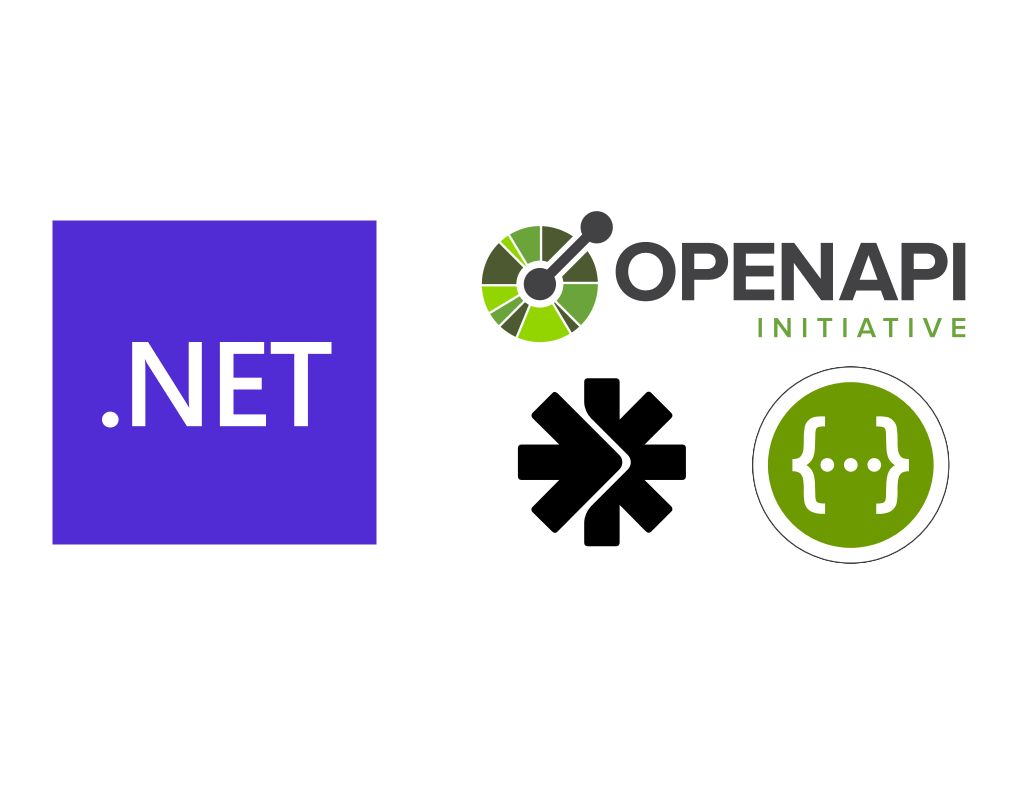
The good’ol days
Previously in .NET 8 with Swashbuckle Swagger/NSwag we could use the CustomSchemaIds extension method and provide a transformation delegate to support fully qualified type names for nested types in the schema. Here is the original suggestion (as far as I can tell) on GitHub: https://github.com/swagger-api/swagger-ui/issues/7911#issuecomment-1068538276)
Essentially, all we are trying to achieve is to replace the + notation that prefixes the parent class name to the nested class name with the . notation to obtain a display friendly fully qualified type name.
setup.CustomSchemaIds(x => x.FullName?.Replace("+", ".", StringComparison.Ordinal));Now that the future is here
In .NET 9, Swashbuckle has been removed as the default and replaced with a new .NET native implementation for OpenAPI specification document generation. However, now there is no convenient way to achieve the same outcome as we had using that Swashbuckle extension method.
Before diving into the solution, there are some default behaviours to be aware of in the new .NET 9 OpenAPI generated document.
- First, I noticed that for any exactly similarly structured nested types the new schema only displays a single Model entry (as in there are no duplicates).
- Second, if you have nested types with the same name but different structures, then a numbered suffix is added to the typename in the schema.
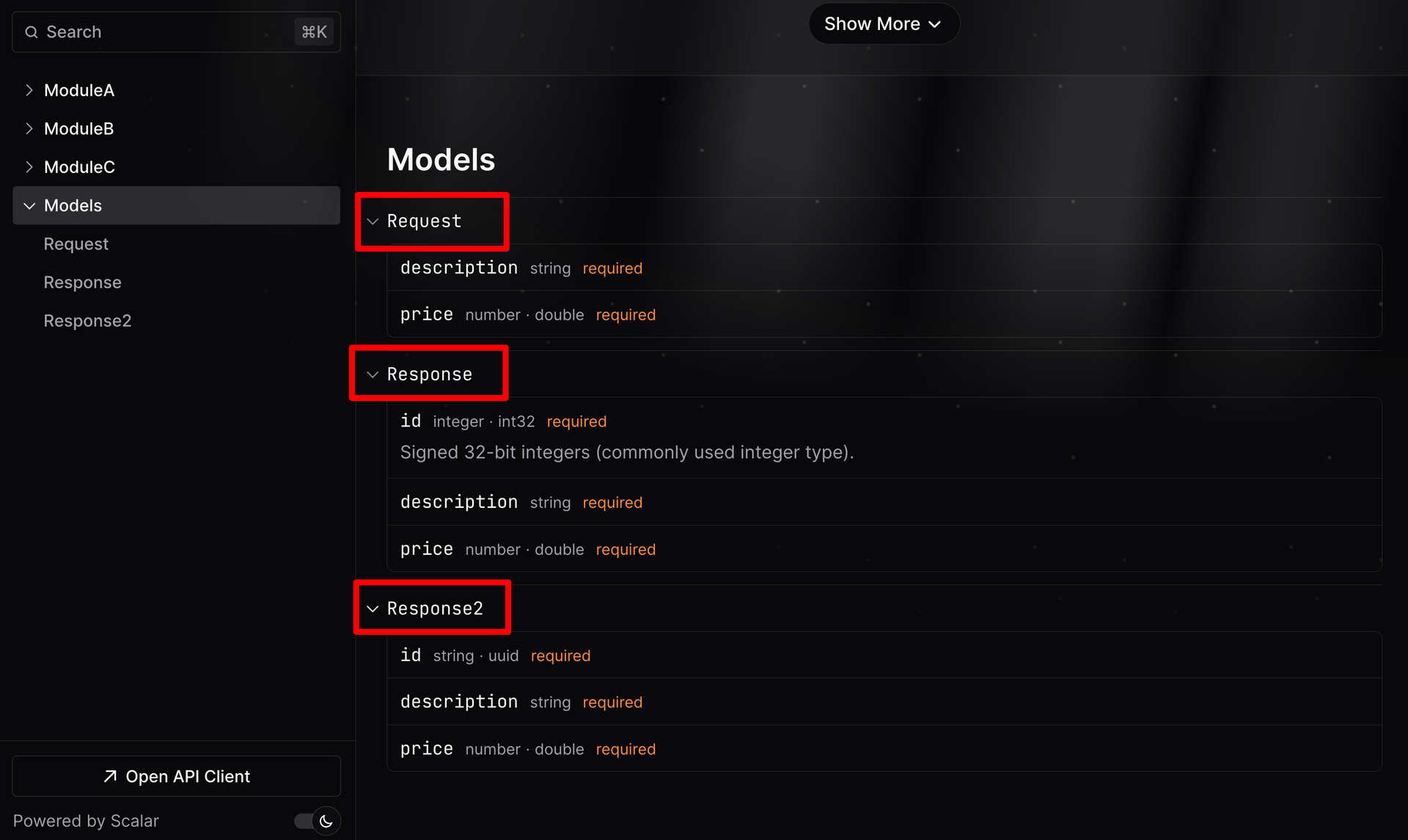 Figure: Scalar UI showing basic model names with numbered suffixes
Figure: Scalar UI showing basic model names with numbered suffixes
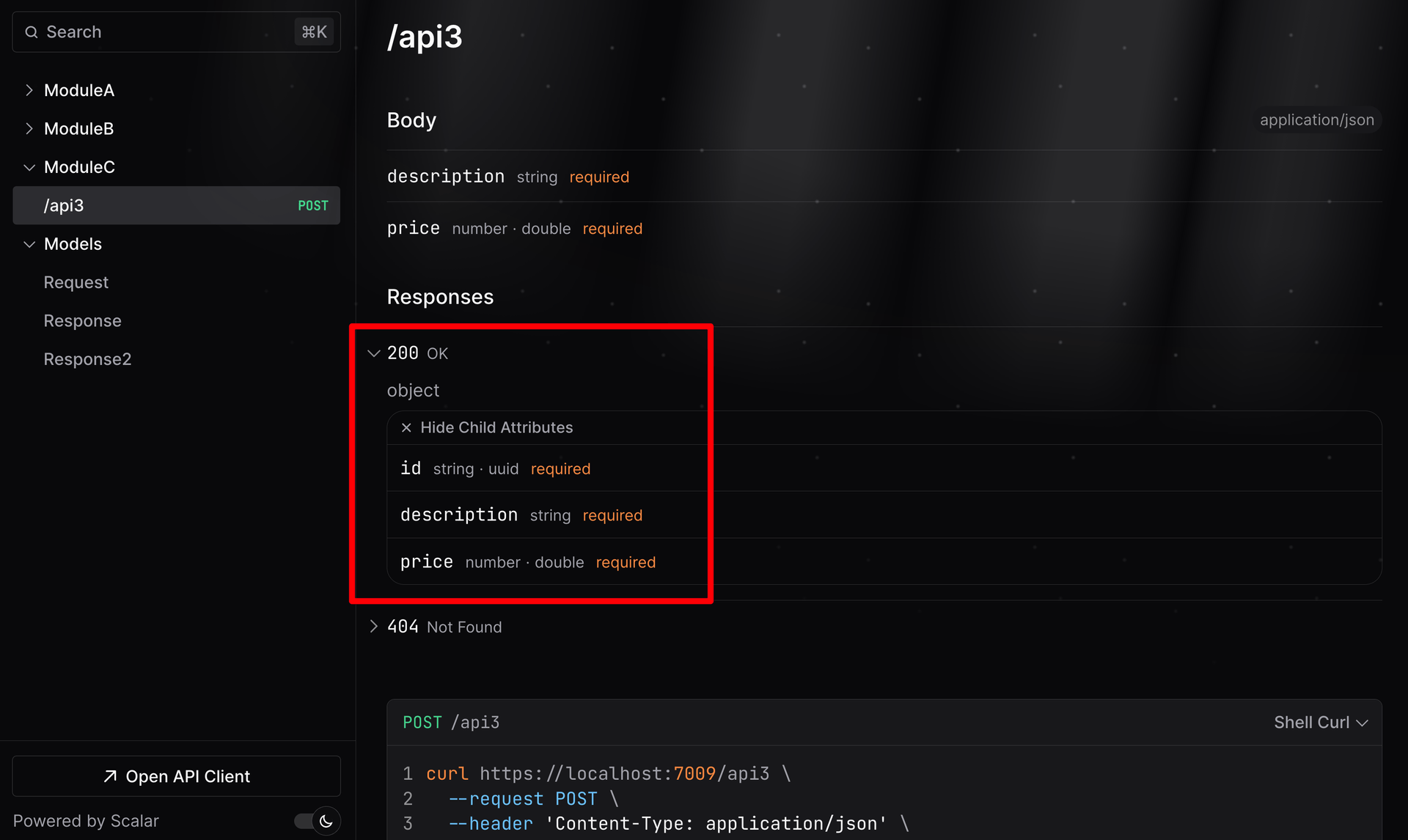 Figure: Scalar UI not showing any model names, just the object schema
Figure: Scalar UI not showing any model names, just the object schema
Neither of these behaviours is what I am looking for. Also, when expanding the endpoint to inspect the body or response schemas, there are no type names displayed either. Without the full type name, I cannot tell exactly which model the UI is referring to in my codebase. I NEED THE FULL TYPE NAME!!
So, after a bit of experimentation I got my own version of the beloved CustomSchemaIds implementation working. The next section will cover all the details of the implementation.
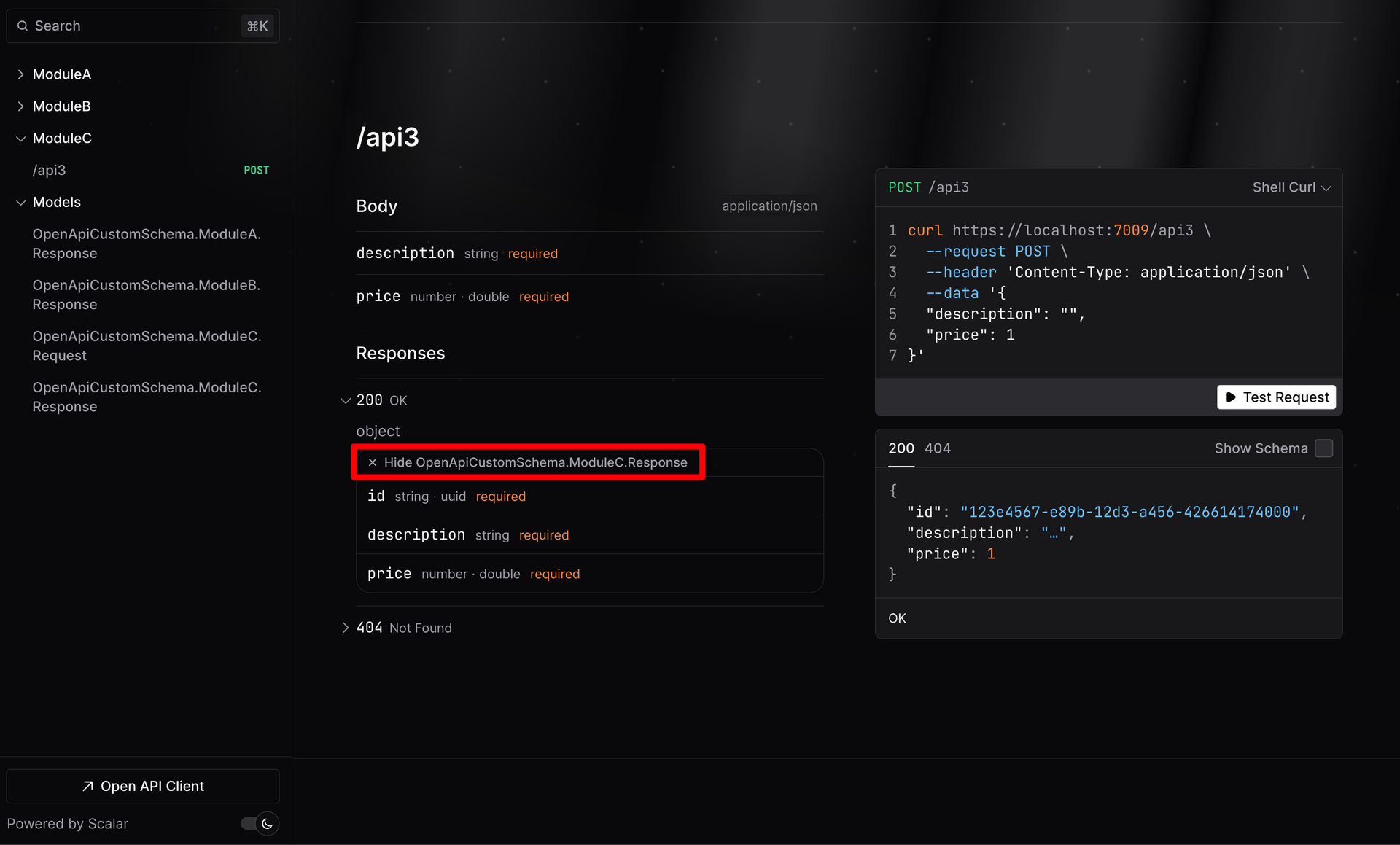 Figure: Expanding the response schema now shows the full type name
Figure: Expanding the response schema now shows the full type name
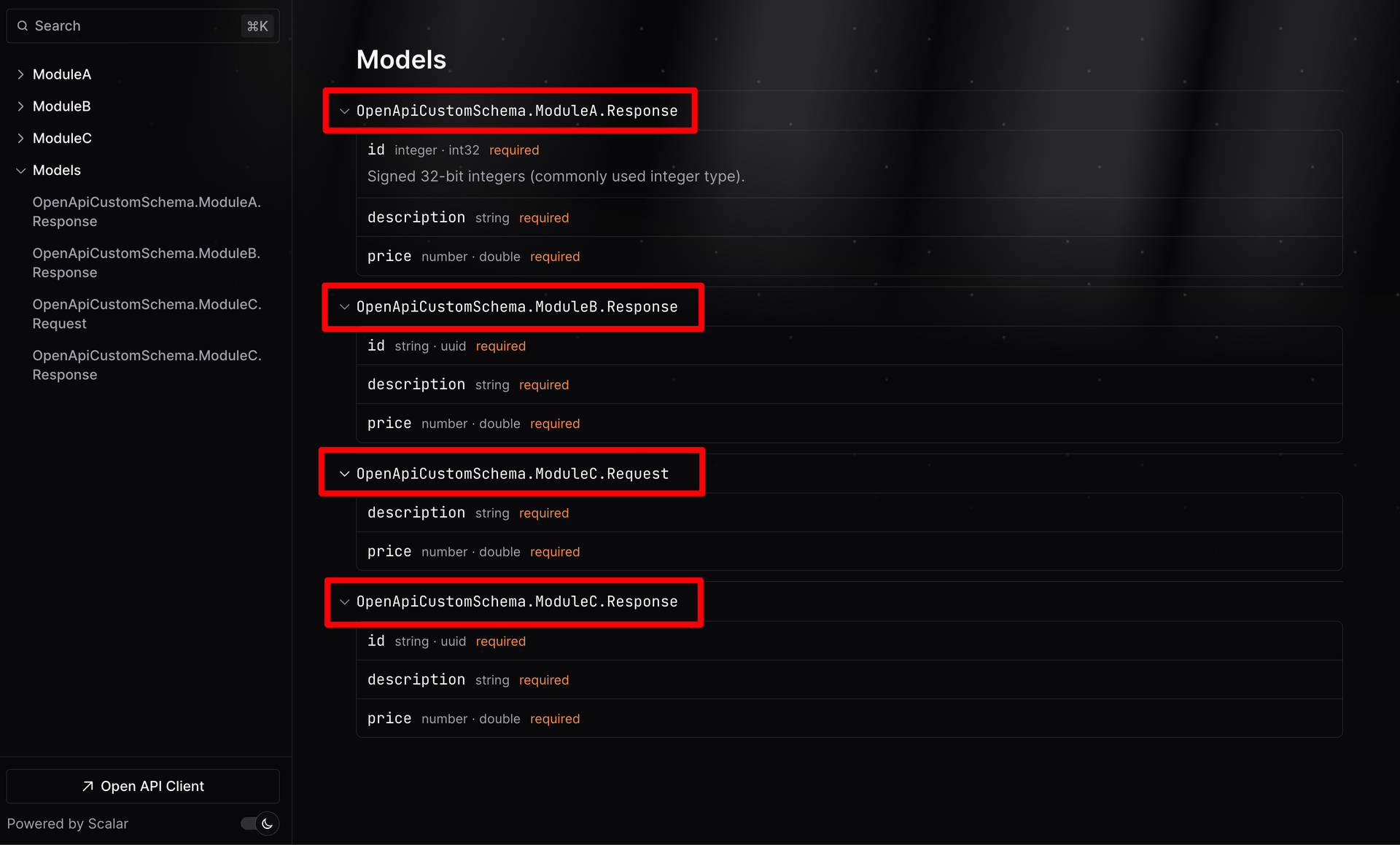 Figure: The Models section now shows the full type name - no ambiguity!
Figure: The Models section now shows the full type name - no ambiguity!
Finally! The schema is showing me everything I need.
Now lets look at how the extension method works and how you can use it in your own applications.
How to transform the OpenAPI schema types
I created this extension method to modify the OpenAPI schema generation process by allowing type names to be transformed using a delegate method. So you can modify the type names however you see fit.
Here is the all the code for the extension method:
using Microsoft.AspNetCore.OpenApi;
public static class OpenApiExtensions
{
public static OpenApiOptions CustomSchemaIds(this OpenApiOptions config,
Func<Type, string?> typeSchemaTransformer,
bool includeValueTypes = false)
{
return config.AddSchemaTransformer((schema, context, _) =>
{
// Skip value types and strings
if (!includeValueTypes &&
(context.JsonTypeInfo.Type.IsValueType ||
context.JsonTypeInfo.Type == typeof(String) ||
context.JsonTypeInfo.Type == typeof(string)))
{
return Task.CompletedTask;
}
// Skip if the schema ID is not already set because we don't want to decorate the schema multiple times
if (schema.Annotations == null || !schema.Annotations.TryGetValue("x-schema-id", out object? _))
{
return Task.CompletedTask;
}
// transform the typename based on the provided delegate
string? transformedTypeName = typeSchemaTransformer(context.JsonTypeInfo.Type);
// Scalar - decorate the models section
schema.Annotations["x-schema-id"] = transformedTypeName;
// Swagger and Scalar specific:
// for Scalar - decorate the endpoint section
// for Swagger - decorate the endpoint and model sections
schema.Title = transformedTypeName;
return Task.CompletedTask;
});
}
}-
The
CustomSchemaIdsmethod adds a schema transformer to the OpenAPI configuration by callingAddSchemaTransformerand receives a delegatetypeSchemaTransformerthat callers can use for the custom transformation of types. -
This transformer is a function that takes three parameters:
schema,context, andcancellationToken. We are mainly interested in theschema, and the currentcontextobjects to perform our transformations. -
The function first checks if the type information (
context.JsonTypeInfo.Type) is avalue typeor astring.- If it is, the function returns immediately using
Task.CompletedTask, indicating that no transformation is needed for these types - I like to keep them as simple as possible.
FYI - if we fully qualify
value typesthen they appear asSystem.Double,System.Guid,System.Int32,System.Stringinstead ofdecimal,guid,int,string:( - If it is, the function returns immediately using
-
Next, the function checks if the
schema.Annotationsdictionary is null or does not contain thex-schema-idkey.- If either condition is true, the function again returns
Task.CompletedTask, as there is no schema ID to modify. - If the schema ID is present, the function updates the
x-schema-idannotation and theschema.Titleproperty with the transformed type name.
- If either condition is true, the function again returns
-
The transformed type name is obtained by executing the provided
typeSchemaTransformerdelegate and passing thecontext.JsonTypeInfo.Typevalue to be transformed.
I did have to take a bit of care to make it work for both SwaggerUI and the newer Scalar UI. Both libraries interpret the OpenAPI spec document slightly differently.
- SwaggerUI uses the
titlefield from the schema to represent the type name throughout the UI - Scalar uses the
titlefield from the schema to represent the type in the endpoints section of the UI - Scalar uses the
x-schema-idannotation to represent the type in the models section of the UI
With this extension method, I managed to achieve a consistent outcome for both SwaggerUI and Scalar.
Nice and simple!
Now lets look at using this extension method in our own applications.
Custom Schema Transformations
In your Program.cs file, use the extension method above as part of your OpenAPI application services configuration:
var builder = WebApplication.CreateBuilder(args);
// Add OpenAPI spec generation using the AddOpenApi extension method
builder.Services.AddOpenApi(config =>
{
//
// with .NET 9 OpenApi, to support fully qualified type names for nested types in the schema, use the
// CustomSchemaIds extension method (but from our own extension method :) )
//
config.CustomSchemaIds(x => x.FullName?.Replace("+", ".", StringComparison.Ordinal));
});
var app = builder.Build();In my case I use the CustomSchemaIds extention method to transform the context type to nicely display as a fully qualified type name (e.g. namespace.classname, namespace.classname.nestedclassname). This transformation ensures that both the model and endpoint sections of the OpenAPI documentation use fully qualified type names. I find that it simply enhances the clarity and specificity of the generated API documentation when using nested types.
Add some UI middleware to render your OpenAPI document
In your Program.cs file, configure the OpenAPI middleware with your specific route, as well as configuring Swagger UI and Scalar UI to read the OpenAPI doc at the specific route.
(I went a bit furhter and customised both UIs with my own flare)
WebApplication app = builder.Build();
app.UseHttpsRedirection();
// Map an endpoint for viewing the OpenAPI document in JSON format
// Link: https://localhost:7009/openapi/v1.json
const string documentName = "v1";
app.MapOpenApi("/openapi/{documentName}.json");
// Map an endpoint for viewing the OpenAPI document in via the Scalar UI
// Link: https://localhost:7009/scalar
app.MapScalarApiReference(o =>
{
o.WithTheme(ScalarTheme.DeepSpace)
.WithModels(true)
.WithSidebar(true)
.WithLayout(ScalarLayout.Modern)
.WithClientButton(true)
.WithOperationSorter(OperationSorter.Method)
.WithDotNetFlag(true)
.OpenApiRoutePattern = "/openapi/{documentName}.json";
});
// Map an endpoint for viewing the OpenAPI document in via the Swagger UI
// Link: https://localhost:7009/swagger
app.UseSwaggerUI(
Theme.UniversalDark,
setupAction: options =>
{
options.RoutePrefix = "swagger";
options.SwaggerEndpoint($"/openapi/{documentName}.json", documentName);
});Next, in your Program.cs, add some basic API endpoints:
app.MapGet("/api1", ModuleA.Execute)
.WithName("GetSomethingFromModuleA");
app.MapGet("/api2", ModuleB.Execute)
.WithName("GetSomethingFromModuleB");
app.MapPost("/api3", ModuleC.Execute )
.WithName("AddSomethingToModuleC");Define the modules that contain the module specific route handlers:
// ModuleA.cs
internal static class ModuleA
{
public record Response(int Id, string Description, double Price);
public static async Task<Results<Ok<Response>, NotFound<int>>> Execute(int id)
{
var resp = new Response(1, "Thing from Module A", 100.0);
return await Task.FromResult(TypedResults.Ok(resp));
}
}// ModuleB.cs
internal static class ModuleB
{
public record Response(Guid Id, string Description, double Price);
public static async Task<Results<Ok<Response>, NotFound<int>>> Execute(int id)
{
var resp = new Response(Guid.NewGuid(), "Thing from Module B", 200.0);
return await Task.FromResult(TypedResults.Ok(resp));
}
}// ModuleC.cs
internal static class ModuleC
{
public record Request(string Description, double Price);
public record Response(Guid Id, string Description, double Price);
public static async Task<Results<Ok<Response>, NotFound<int>>> Execute(Request request)
{
var resp = new Response(Guid.NewGuid(), request.Description, request.Price);
return await Task.FromResult(TypedResults.Ok(resp));
}
}Now that you have everything in place, run the application and navigate to one of the UI routes:
Notice that we now have the nested types nicely displayed without any ambiguity :)
That is all. I hope you enjoy using this neat little extension to make your API docs easier to read!
Check out the full source code on my GitHub.
I give .NET 9 OpenAPI document generation 💎💎💎💎 gems!
